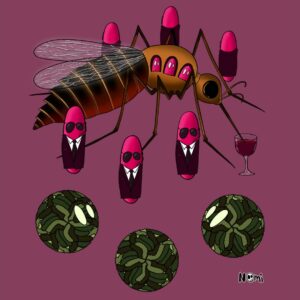As a microbiologist, I am often asked what are the differences between viruses and bacteria.
Are both of them microbes or germs?
Can we get sick from both?
Do antibiotics work against both? (Spoiler: no they don’t!)
And which ones are smaller again?
I hope I can answer most of these questions in the following overview.
If you want to refresh your memory on what bacteria are and how they function, you should head to the page “What are bacteria“. But here, let’s learn about the differences between bacteria and viruses.
What are the differences between bacteria and viruses?
Bacteria are considered living organisms – viruses not.
Researchers are constantly arguing about this point of view. And I don’t really think there is a right or wrong.
I, however, think that viruses should not count as living organisms. This is mainly due to the following differences between bacteria and viruses:
1. Bacteria can reproduce on their own
Bacteria grow on their own by cell division. Viruses need host cells for their production.
2. Bacteria can produce energy
Bacteria can produce their own energy by metabolising nutrients, meaning digesting food. However, viruses are unable to metabolise anything to make energy.
This also means that bacteria produce cell components that they need so they can grow themselves. Viruses take all that energy from their host.
3. Bacteria can interact with their environment
Bacteria are extremely complex! They can talk to each other and adapt to the environment, importing and exporting molecules. Viruses are not able to adapt to their environment on a metabolic level.
4. Bacteria have a complex cell structure
Bacteria have a cell wall or a double cell membrane. This protects the inner content of the cell from the environment.
The viral envelope is a coat made of proteins and lipids. These lipids come from the host cell that originally produced the virus particle.

5. A bacteria cell is full
The bacterial cell is filled with proteins, ribosomes and all the “stuff” the cell needs to grow, divide and produce anything.
A virus is only filled with the genome, which can be DNA or RNA. Often, proteins inside the virus particle help condense the genome to make it smaller.
6. The host produces the viruses
When a bacterium infects a cell, it still works as an organism. The bacterium can interact with the host cell, metabolise, grow and reproduce.
When a virus infects a host cell, it breaks into its single components: the proteins and the genome. Thus, the virus particle itself does not exist anymore.
The virus then releases its genetic material into the host cell. The virus DNA or RNA then tricks the host cell into reading the virus DNA/RNA instead of the host DNA.
Now, the host thinks it is reading its own DNA/RNA and produces lots of virus complexes. The virus complexes then assemble into full virus particles and leave the cell.

In any case, a virus requires the host to produce the virus.
Without a host, no virus can replicate.
This is why throughout evolution, viruses evolved that are highly infectious. Thus, the virus easily spreads and more and more virus particles can be produced.
As I keep saying, every organism wants to survive.
7. Bacteria can actively move
Most bacteria can actively move or swim with their flagellum. They use this movement to actively look for nutrients or evade dangers.
On the contrary, viruses do not have such a mechanism and require spread by host acceleration. This spread is generally triggered by the virus itself.
For example, one such mechanism is sneezing, which we only do thanks to viruses. When we sneeze, we accelerate the virus out of our bodies. Thus, by sneezing the virus out, it can spread to another host and infect it.
This is why you should cover your mouth when sneezing!
8. There are no “good” viruses
Another important difference between bacteria and viruses is that bacteria actually help our organisms. We can consider these as “good” bacteria.
No virus is actually advantageous for a host, as it always hijacks the host machinery to produce the virus particles. And in most cases, this is deadly for the host cell.
However, a novel study just found a way for how viruses protect their hosts. You can read the article “Love thy host” about this new concept.
9. Antibiotics inhibit bacteria – NO VIRUSES!
Antibiotics only work against bacteria!
This is because antibiotics inhibit cell functions that are only present in the bacterial cell. You can read more about this in the article about antimicrobial resistance.
Because viral and bacterial cells are different, antibiotics do not have the same targets in viruses.
Viral infections can be treated with antiviral drugs, which work differently than antibiotics. Generally, antiviral drugs inhibit certain steps within the virus replication cycle. But this also affects the host replication cycle, which can be quite bad for the host. This is why developing antiviral drugs is so difficult.
10. Preventing infections with vaccines
Virus infection can only be prevented by vaccines. These vaccines recognise surface proteins within the coat of the virus.
Because the surface of bacteria is different, a vaccine against a virus will not work against a bacterium and the other way around.
11. Bacteria are (often) bigger than viruses
Generally, viruses are a lot smaller than bacteria. But as always, there are exceptions. Giant viruses have been found and so were tiny bacteria about the same size as the common virus.
The real difference between viruses and bacteria: which one is alive?
Okay, now it is up to you to decide whether viruses are living organisms or not. What do you think? Are they just parasites hijacking their hosts? Or is that approach so smart that we should count them as living organisms?
I am looking forward to your thoughts in the comments!










One Response
Welcome